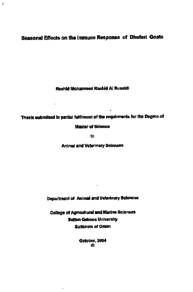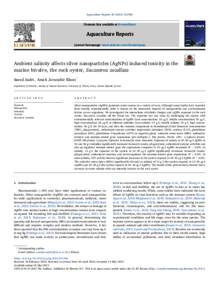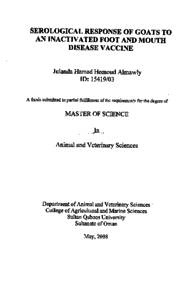Document
Seasonal effects on the immune response of Dhofari goats
Publisher
Sultan Qaboos University
Gregorian
2004
Language
English
English abstract
Goats are held in large numbers in Oman and are widely appreciated for their meat. Infectious diseases are important risk factors that limit their production and increase the cost of management. The study of the caprine immune system is therefore crucial for an understanding of the host - parasite interaction in this species. Generally, It is assumed that heat stress, leads to suppression of the immune system and therefore increases the susceptibility of these animals to disease. However, based on a number of observations at the field level, it appears that morbidity and mortality figures in goats increase for a significant number of diseases during the winter months of the year versus the summer
months. This study is, therefore, an attempt to investigate the effect of seasonal variations on different immune system parameters, including the bactericidal activity of caprine polymorphonuclear granulocytes (PMNs) against the target bacteria Staphylococcus aureus (Staph. aureus) and the production of serum immunoglobulins. In addition, serum
cortisol, total protein and hematological values were measured. Six healthy male goats approximately one year of age were maintained together in a closed pen at the Agriculture Experimentation Station at Sultan Qaboos University for a period of one year. The goats were fed Rhodesgrass hay ad libitum and a commercially prepared ruminant concentrate. Blood samples were collected monthly for hematological, serological and cortisol analysis, as well as to study the phagocytic activity of PMNs. An automated weather station was
used for meteorological monitoring of solar radiation, air temperature, relative humidity, rainfall and wind speed as well as photoperiod. The average ambient temperature during the winter (October – March) was 24 0.3°C versus 34 + 0.3°C in the summer (April – September) (P<0.05). The photoperiod was significantly shorter in the winter versus the summer, 9.6 + 0.5 and 11.3 + 0.8, respectively. During summer, there was an increase in the level of serum IgG (P<0.05), and an increase in the phagocytic activity of PMNS against Staph. aureus (P<0.05). Also during the summer season there were significantly lower levels (P<0.05) of serum cortisol (26.5 + 2.2) than that recorded during the winter season (34.9 5.1). During the summer the goats had higher WBC (P<0.05), lymphocyte (P<0.05) and eosinophil counts (P=0.05) than during the winter season. There were no statistical differences in neutrophil (P=0.32), monocyte (P=0.47) and basophil counts (P=0.7) between the two seasons. The seasonal differences in phagocytic activity and levels of IgG could have been partially related to varying cortisol levels. However, it could also have been related to differing photoperiods during the two seasons. The increase in the eason incidence of various infectious diseases during the winter season in goats in Oman may be at least partially due to suppressed phagocytic and/or opsonisation activity.
Description
Thesis
Member of
Resource URL
Arabic abstract
يربي الماعز في عمان باعداد كبيرة وذلك لأهميتها في إنتاج اللحم. تعتبر الأمراض من أهم العوامل التي تؤدي إلى ضعف إنتاجيتها ورفع مستوى تكلفة تربيتها. ولذلك دراسة الجهاز المناعي للماعز مهم في فهم العلاقة بين الماعز والأمراض بشكل عام.. هناك معتقد علمي بأن ارتفاع الحرارة يؤدي إلى إضعاف الجهاز المناعي وبالتالي زيادة الإصابات بالأمراض. بالنضر إلى كثير من الملاحظات في المزارع، يظهر أن ارتفاع معدلات الوفيات يحدث بشكل كبير في فصل الشتاء عنة في فصل الصيف. هذه الدراسة هي محاولة للاجابه عن تأثير عوامل الطقس في الجهاز المناعي.. وخاصة في قدرة الخلايا الآكلة ضد بكتيريا استفلوکوک اوریوس ( Staph . aureus ) وأيضا في إنتاجية المضادات الحيوية .. وكمية كورتزول الدم و كريات الدم البيضاء في الماعز. ستة ذكور ماعز ظفارية ذات سنة واحدة من العمر وضعت مع بعضها في مركز التجارب الزراعية بجامعة السلطان قابوس. جميع الحيوانات غذيت بعليقه متكاملة من المواد الغذائية والماء. عينات الدم تؤخذ بشكل شهري الفحص الدم، وقياس الكورتزول و دراسة الخلايا الأكلة. استخدم جهاز قياس الطقس لدراسة درجة الحرارة، معدل الرطوبة و كمية الضوء.
متوسط درجة الحرارة خلال فصل الشتاء (أكتوبر - مارس) هي (24+0 (.3 درجة مؤوية مقابل (34 + 0( . 3 درجة مؤوية في الصيف ( ابريل - سبتمبر) ( 0 (. 05>P مدة الضوء اقل بشكل نسبي في فصل الشتاء (9( . 6 + 0 . 5) مقارنة بفصل الصيف (11 (. 3 + 0 . 8. ايضا في فصل الصيف هناك ارتفاع ملحوظ في مستوي امیونوجلوبيلين ج ( P < 0 . 05 ) ( IgG ). وزيادة في قدرة الخلايا الأكلة ضد بكتريا الستفلوكوكس اريوس ( 0 . 05>P) . ايضا خلال فصل الصيف هناك انخفاض ملحوظ ( 0 . 05>P) في نسبة الكورتزول في الدم (26 . 5 + 2 . 2) عن تلك التي سجلت في فصل الشتاء (34 . 9 (+ 5 . 1. في فصل الصيف سجل الماعز ارتفاع في عدد كريات الدم البيضاء ((. 05>P، اللمفوسيت (. 05 >P)، و الاثيوسينوفل ( 0 (. 05>P مقارنة بفصل الشتاء. لم يظهر أي تغير ملحوظ في عدد النيوترفل (. 32 =P)، المونوسیت ( 0 (. 47=P) و البيسوفل 0( . 07 =P) في الفصلين. الاختلافات الفصلية في قدرة الخلايا الأكلة ومستوى الاميونوجلوبيولين (IgG) ربما تعزى بشكل جزئي إلى اختلاف مستوى الكورتزول ، او ربما ترتبط باختلاف مدة الضوء خلال الفصلين. الارتفاع في معدل الإصابة بالأمراض خلال فصل الشتاء في الماعز في عمان ربما يعود بشكل جزئي إلى ضعف الخلايا الأكلة و/ أو ربما ضعف نشاط المضادات الحيوية.
متوسط درجة الحرارة خلال فصل الشتاء (أكتوبر - مارس) هي (24+0 (.3 درجة مؤوية مقابل (34 + 0( . 3 درجة مؤوية في الصيف ( ابريل - سبتمبر) ( 0 (. 05>P مدة الضوء اقل بشكل نسبي في فصل الشتاء (9( . 6 + 0 . 5) مقارنة بفصل الصيف (11 (. 3 + 0 . 8. ايضا في فصل الصيف هناك ارتفاع ملحوظ في مستوي امیونوجلوبيلين ج ( P < 0 . 05 ) ( IgG ). وزيادة في قدرة الخلايا الأكلة ضد بكتريا الستفلوكوكس اريوس ( 0 . 05>P) . ايضا خلال فصل الصيف هناك انخفاض ملحوظ ( 0 . 05>P) في نسبة الكورتزول في الدم (26 . 5 + 2 . 2) عن تلك التي سجلت في فصل الشتاء (34 . 9 (+ 5 . 1. في فصل الصيف سجل الماعز ارتفاع في عدد كريات الدم البيضاء ((. 05>P، اللمفوسيت (. 05 >P)، و الاثيوسينوفل ( 0 (. 05>P مقارنة بفصل الشتاء. لم يظهر أي تغير ملحوظ في عدد النيوترفل (. 32 =P)، المونوسیت ( 0 (. 47=P) و البيسوفل 0( . 07 =P) في الفصلين. الاختلافات الفصلية في قدرة الخلايا الأكلة ومستوى الاميونوجلوبيولين (IgG) ربما تعزى بشكل جزئي إلى اختلاف مستوى الكورتزول ، او ربما ترتبط باختلاف مدة الضوء خلال الفصلين. الارتفاع في معدل الإصابة بالأمراض خلال فصل الشتاء في الماعز في عمان ربما يعود بشكل جزئي إلى ضعف الخلايا الأكلة و/ أو ربما ضعف نشاط المضادات الحيوية.
Category
Theses and Dissertations



